By Nicky Snoyink, Forest & Bird Canterbury/West Coast Regional Manager If you have ever been lucky enough to visit the Southern Alps alpine zone, you will be familiar with some of the 750+ native alpine plants species, subspecies and...
By Nicky Snoyink, Forest & Bird Canterbury/West Coast Regional Manager
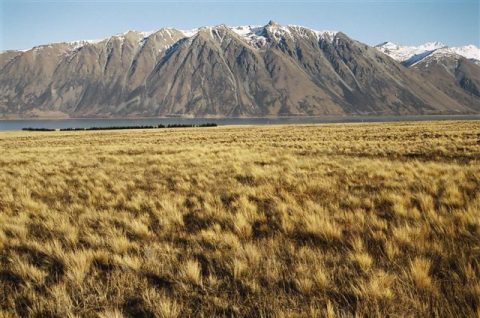
If you have ever been lucky enough to visit the Southern Alps alpine zone, you will be familiar with some of the 750+ native alpine plants species, subspecies and varieties and associated native animals that live there.[1] You may have even seen a Himalayan tahr or twenty. Recent controversy over tahr control prompts me to take a closer look at just what is at stake in the alpine zone.
In his book Above the Treeline: A Nature Guide to Alpine New Zealand Sir Alan Mark describes New Zealand’s extraordinary alpine plant communities according to altitude.
Low alpine vegetation (the vegetation just above the bush line) includes a sequence of…
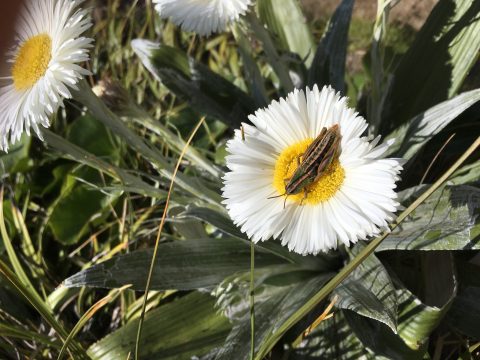
A grasshopper on a mountain daisy
…and high alpine vegetation includes…
fellfields dominated by stable rock screes where surface rock is loose tundra like cushion vegetation, and snow bank vegetation, where snow persists late into the summer.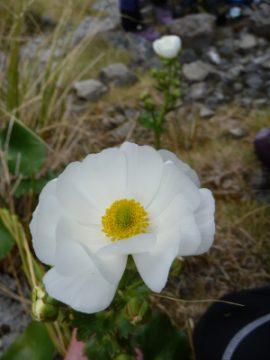
Mount Cook buttercup
Along with a variety of tussock species, the alpine plant communities contain many other species
at least 19 species of buttercups more than 50 species of mountain daisies 16 species of vegetable sheep and mat daises, 38 Spear-grass species; and South Island edelweiss.[2]Many of these species are endemic to New Zealand which means they are found nowhere else on the planet. Many of these species are also highly palatable to tahr, an introduced large goat-like creature native to the mighty Himalayas.
Those alpine plant communities are habitat and food sources for native insects including wetas, spiders, lizards, moths and grasshoppers. New Zealand has 15 species of grasshopper, 12 of which are found in the mountains! [3]
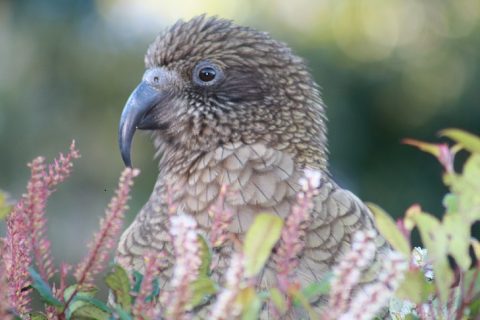
Kea
Some insects have a chemically complex relationship with the plants they eat, and become dependent on a single type of plant, like for example the Speargrass weevil.[4] Specially adapted alpine birds like Kea (nationally threatened) and rock wren (endangered) also choose this alpine environment as home. Mark notes that in 2008, while 75% of alpine plants were considered not threatened, almost 20% were naturally uncommon, and the remaining 5% span the range from nationally critical (1.3%) to data deficient (1.1%). [5] Studies show that kea alone eat over 200+ different varieties of natural foods including a wide range of animal and vegetable matter.[6]
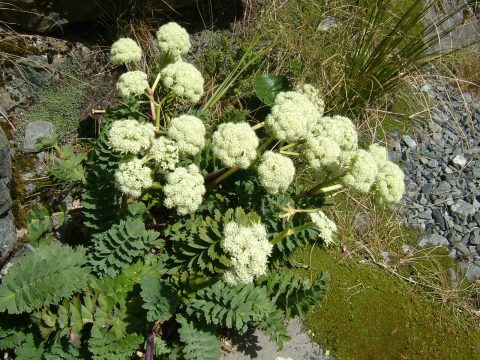
Bristly alpine carrot
Aoraki/Mount Cook and Westland Tai Poutini National Parks have been protected for their intrinsic worth and for the preservation of the native plants and animals. Subject to that preservation, the public have freedom of entry and access to the parks, so that they may receive in full measure the inspiration, enjoyment, recreation, and other benefits that may be derived from mountains, forests, sounds, seacoasts, lakes, rivers, and other natural features.[7]
The current National Parks Act is a rewrite of the 1952 National Parks Act, which sets out the priority principle of preservation in perpetuity of natural features.[8] Earlier versions of the Act contained a similar principle and actually threatened imprisonment for removing plants or animals, and for unauthorised shooting of animals with a gun in national parks![9]
Himalayan tahr were introduced to New Zealand at Mt Cook in 1904 and have since established breeding populations over about 7000 square kilometres of the Southern Alps. They were completely or partially protected until 1930, and then considered pests. From 1937 onwards tahr were culled by Government employees. DOC inherited management of tahr and decided it needed to undertake control of the animals to fulfil its conservation obligations. As it was not possible to eradicate tahr from New Zealand, the Departments policy is to “ensure that hunting and other control pressure is maintained at levels which provide protection to natural values”. [10]
The 1993 HimalayanTahr Control Plan (the HTCP) identifies the tahr feral range and sets a total limit of 10,000 animals. The tahr feral range includes a stretch of the Southern Alps from the Wanaka/Haast Highway north to the Rakaia/Whitcombe Rivers. The tahr feral range includes national parks, other public conservation land (PCL), Crown Pastoral lease lands administered by Land Information New Zealand (LINZ) and private land.[11]
The HTCP describes seven management units within the tahr feral range that contain limits for tahr populations based on management goals to protect conservation values.[12] The Aoraki/Mount Cook & Tai Poutini Westland National Parks are located within management unit 4 (MU 4) and make up approximately 20% of the tahr feral range. MU4 has a target density of zero tahr and a management goal of controlling the population to the lowest practicable level. This is consistent with the national park management plans and the National Parks Act, to ensure natural values are protected and preserved. The HTCP has remained unchallenged since 1993.
Each year DOC should establish an operational plan to control the tahr population within HTCP limits. Prior to 2018 it is unclear to what extent this had been occurring. In 2018, the New Zealand Conservation Authority raised concerns with the Department about exploding populations of tahr. Initial reports stated that the tahr population on PCL (including national parks) alone could be anything between 26,000 and 45,000 and there were concerns about the level of impact (grazing and trampling) that this number of tahr was having on native alpine plant communities. Species particularly vulnerable are tussocks, some buttercup species, mountain daises and speargrass. There are concerns that some plant communities are being pushed to a point where without urgent intervention recovery will be slow, if ever.
Despite tahr control efforts (which are offset by breeding), the latest monitoring report confirms the tahr population on PCL was estimated to be approximately 35,000.[13] This number does not include tahr on private land or LINZ land within the feral range, as this land is yet to be surveyed. So, the total tahr population is likely to be even higher than 35,000.
Forest & Bird is a member of the Tahr Control Plan Implementation Liaison Group (TCPILG). This group was established to advise DOC on annual tahr control requirements as per the HTCP. The TCPILG is administered by DOC and members include wild animal recover operators, recreational hunting, commercial guided hunting and tahr farming interests, conservation board and conservation authority members. Members of the Game Animal Council also attend. FMC is a member and Forest & Bird is the sole independent conservation voice. It is understood that prior to August 2018 this group had not met for some time.
Since the TCPILG meetings restarted in August 2018, Forest & Bird has attended but became increasingly frustrated by the dominance of hunting interests and the capitulation by DOC especially to some outspoken commercial hunting interests.
In March 2020, Forest & Bird made a declaration to the High Court on the 2019/2020 tahr operational plan on the basis that the operational plan did not comply with the statutory requirements, by seeking to leave bull tahr in the national parks and because of its “transitional nature” which provided no confidence that the numbers in the HTCP would ever be met.
Subsequently, DOC produced the 2020/2021 operational plan of which Forest & Bird could support some elements, notably the provision to stop the practice of not targeting bull tahr in the national parks and the increased effort (250 helicopter hours up from 80 the previous year) within the feral range. However we remained concerned about helicopter hours as a measure of effort because it is not clear how this relates to actual tahr numbers controlled.
In July 2020 the NZ Tahr Foundation, a collective of hunting interests, sought an injunction against the 2020/2021 operational plan because they believed bull tahr in national parks should not be controlled by DOC (despite statutory requirements to aim for zero density of introduced animals in national parks). They also argued that the proposed level of official control would decimate the tahr hunting industry.
The High Court decision on the NZ Tahr Foundation’s case instructed the Department to not further delay tahr control and to use half of the 2020/2021 operational plan effort where it saw fit, immediately. The decision also stated that there was no reason to not target all tahr in the national parks. DOC were criticised for the lack of consultation on the 2020/2021 operational plan and have been instructed to undertake further talks with the TCPLIG to discuss where and how the remaining effort will be used to transition towards the legally allowed population of 10,000 tahr.
In light of this decision Forest & Bird is reviewing its own High Court proceedings. The 2020/2021 operational plan addresses some of our concerns. We recognise the need for better monitoring and understanding of the impacts of grazing and trampling of these large goats on fragile alpine ecosystems and will be contributing to the conversation about how this will look in future.
No one is seeking to eliminate the tahr population completely. By law this is not possible, a total population of 10,000 tahr is allowed. No one objects to the hunter who wants to take the kids out to teach them how to hunt and harvest some organic wild meat for the dinner table, in fact Forest & Bird encourage more of that and we’d strongly recommend taking Sir Alan Mark’s book on your next adventure. Hunting and wild animal recovery is recognised as the primary means of tahr control and then annual official control by the Department needs to happen where HTCP limits are not met.
Forest & Bird strongly believes that the national parks are refuges for native species, first and foremost. The “protect and preserve natural values” prerogative is clearly set out in the National Parks Act, the national park management plans and the HTCP itself. We need certainty that the national park natural values are protected, especially the full suite of native alpine plants and animals in the full sense [14] and that they are not sacrificed for any special group of users. This is a bottom line for Forest & Bird.
References:
[1] Mark, A.F. (2012) Above the Treeline: A Nature Guide to Alpine New Zealand
[2] Mark pp.36-46
[3] Shaun Barnett. Head in the Clouds. Accessed 8 July 2020 at https://www.nzgeo.com/stories/heads-in-the-clouds/
[4] Mark p438 and Speargrass weevil Accessed 8 July 2020 https://teara.govt.nz/en/insects-overview/page-9
[5] Mark, A.F. Above the Treeline: A Nature Guide to Alpine New Zealand p.14
[6] Kea Conservation Trust Kea diet accessed 14 July 2020 at https://www.keaconservation.co.nz/kea/kea-diet/
[7] The National Parks Act 1980 s 4 and National Park Management Plans for Aoraki and Westland
[8] National Parks Act 1980 s4 & National Parks Act 1952 s 3(2)b)
[9] Public Reserves, Domains, and National Parks Act 1928 s 83 (1) (e)
[10] Parkes, J.P. and C. Thomson, C. 1995 Management of Thar. Report for DOC
[11] Himalayan Tahr Control Plan (HTCP) 1993 Accessed 8 July 2020 at https://www.doc.govt.nz/about-us/science-publications/conservation-publications/threats-and-impacts/animal-pests/himalayan-thar-control-plan-1993/ pp.23-24
[12] HTCP 1993 pp25-31
[13] Ramsey, D.S.L. and Forsyth D.M. September 2019. Estimates of Himalayan Tahr Abundance. Accessed 8 July 2020 at https://www.doc.govt.nz/parks-and-recreation/things-to-do/hunting/what-to-hunt/tahr/tahr-control-operations/
[14] Protect in relation to a resource, means its maintenance, so far as is practicable, in its current state; but includes—
(a) its restoration to some former state; and
(b) its augmentation, enhancement, or expansion
Preservation, in relation to a resource, means the maintenance, so far as is practicable, of its intrinsic values


